Midweek Review
Post-war deceptions
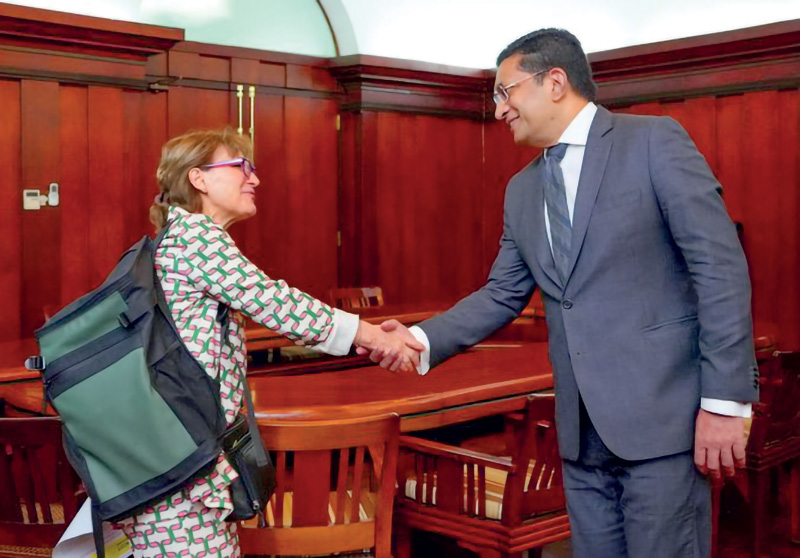
Fifteen years after the eradication of the LTTE, unsubstantiated allegations regarding the number of dead civilians, LTTEers and missing persons persist. Forced disappearances, as alleged by the UN, remains a major issue, with the concerned demanding accountability on the part of Sri Lanka. How many of those who had been categorized as missing are living overseas, under different identities, with passports issued from various countries. Unfortunately, the powers that be seemed to be wholly incapable of building Sri Lanka’s defence. For one and half decades, they shirked their responsibilities. Shame on this lot.
By Shamindra Ferdinando
Parliamentarian Akilan Manoharan Ganesan found fault with the US-led Western powers, successive post-war governments and one-time LTTE mouthpiece, the Tamil National Alliance (TNA) for what he terms the continuing predicament of the Tamil community.
In a statement tweeted on the eve of the 15th anniversary of the conclusion of the war, the former Yahapalana Minister alleged (1) the international community gave Sri Lanka the go ahead for all-out war against the LTTE (2) Sri Lanka ordered the closure of the Vanni Office of the UN to pave the way for war without witnesses (3) international community failed to ensure a political solution nor address accountability issues, as promised (4) Western powers arranged ‘honeymoon’ between Sri Lanka and TNA (5) Tamil community not allowed to commemorate the war dead (6) President Ranil Wickremesinghe response to Tamils’ concerns and grievances questionable (7) UN failed to ensure the Tamils’ right to commemorate war dead and (8) the failure on the part of the US to convince/compel Sri Lanka to address Tamils’ grievances.
MP Ganesan shared the tweet with his leader Sajith Premadasa and Anura Kumara Dissanayake, the leader of the JVP-led Jathika Jana Balawegaya (JJB). Interestingly, when the UNP backed retired war-winning General Sarath Fonseka’s candidature at the 2010 presidential poll, Mano Ganesan’s party was in that coalition, consisting of the UNP, TNA, JVP and SLMC.
Lawmaker Ganesan chided outgoing US Ambassador Julie Chung for the US inaction, despite all of her interferences here, especially in regard to the success of the violent protest movement that ousted the duly elected President Gotabaya Rajapaksa. She conveniently called them peaceful protesters and prevailed on the military and police not to take any action against them. Chung’s successor Elizabeth Horst has already caused controversy by declaring that Sri Lanka imposed a one-year-ban on the entry of foreign research vessels into our waters at their behest. Appearing before the powerful Senate Foreign Relations Committee, Horst has stressed the need for the ban that came into effect on January 1, 2024. The US move, made in consultation with New Delhi, is meant to block visits by Chinese naval vessels.
Let us get back to the issue of post-war consensus among the communities on political solutions, the status of the accountability process and foreign interventions.
Sometimes foreign interventions made for strategic reasons (US interventions here are meant to counter Chinese influence, appease India and influence Tamil community) can be quite devastating. So-called bipartisan US resolution that had been introduced to the US Congress calling on the United States to work towards an independence referendum for Eelam Tamils and recognize the ‘genocide committed against them’ by the Sri Lankan state revealed the superpower’s evil machinations here not having learnt any lessons from their vicious plots executed almost world over. They should at least now open their eyes to the calamity they have created in Palestine by their imperialist plots.
If the US is so sincere in its intentions why not it first create an independent nation for the natives of that country, virtually wiped out by numerous acts of genocide committed by white settlers to grab their land. The few natives who survived such pogroms are still more or less confined to reservations created by white colonialists in most hostile environments. As retribution, the world must demand that the US creates native independent states right across the country for each surviving decimated native tribe.
The same goes for Canada which had been found guilty of killing more than 2000 native children, forcefully boarded at Church run schools there, till themid-1990s to make them assimilate into the white man’s world. The victims’ bodies were found buried in unmarked graves in the precincts of those schools.
The circumstances the resolution compared the Sri Lankan situation to that of South Sudan, Montenegro, East Timor, Bosnia, Eritrea, and Kosovo where independence referendums had been held with support from the United States and other countries are a mystery
Parliamentarians, who represent the Tamil community, not only in the Northern and Eastern Provinces, but the Up country region as well, should state their position on the US proposal. The UNP reduced to just one National List seat in Parliament, the main Opposition party the SJB, largest single group in Parliament, the SLPP, and the new darlings of the West, the JVP, too, should reveal their position.
The US-based Tamil Diaspora seems to be working overtime and appeared to have taken the lead in a high profile campaign to carve out a separate state in the Northern and Eastern Provinces. Their task has been made easier by an utterly corrupt and treacherous political party system, hell-bent on advancing personal agendas even at the expense of the country’s unitary status.
Lawmaker Ganesan’s hard-hitting tweet must have surprised Western embassies. Or did Ganesan just fire the first shot for a fresh round of ethnic chaos here with a wink from the evil West, whose hands are tainted with so much innocent blood from across the globe. However, the not so young politician conveniently left out any reference to India, whose leadership cannot absolve itself of responsibility for the consequences of the war here that she laid the foundation for. The death and destruction caused by India, in Sri Lanka, in the ’80s, and the revenge assassination of former Indian Prime Minister Rajiv Gandhi, in May 1991, by an LTTE suicide bomber, underscored their overall involvement here.
Perhaps, MP Ganesan should consider commenting on the origins of the war as well. The accountability issue cannot be discussed, leaving out India, as she lost nearly 1,500 military personnel fighting the LTTE (July 1987-March 1990).
Having entered the Colombo Municipal Council, in 1999, on the People’s Front ticket, Ganesan successfully contested the Colombo District at the 2001 General Election on the UNP ticket. He was re-elected at the 2004 General Election on the UNP-led UNF ticket. At the 2010 General Election, he moved from Colombo to Kandy but failed to retain his seat. In the following year, he was back at the CMC after successfully contesting the 2011 Local Government polls on the Democratic People’s Front (DPF) ticket. At the Provincial Council polls held in 2014, he was elected to the Western Provincial Council as a DPF member.
The 2015 General Election marked a significant change in Ganesan’s political life when the Yahapalana leadership granted him a newly created National Dialogue portfolio. In the wake of the UNP split in 2019/2020, following the 2019 presidential election, Ganesan switched his allegiance to the Leader of the breakaway UNP faction, the Samagi Jana Balawegaya, Sajith Premadasa. The outspoken politician contested the last parliamentary poll on the Premadasa–led SJB ticket and was elected from the Colombo district. The war-winning Army Chief is the Chairman of the SJB.
Ganesan leads the DPF (Democratic People’s Front, originally Western People’s Front founded in 2000 to represent the interests of Tamils of Indian origin living in Colombo and its suburbs).
At the onset of the Yahapalana administration, Ganesan played a significant role in establishing the Tamil Progressive Alliance (TPA). In his capacity as the DPF leader, Mano heads the TPA, comprising the National Union of Workers and the Up-country People’s Front.
However, the TPA seems to be sharply divided over political strategy as the country heads for the next presidential poll. At the recently concluded May Day celebrations, TPA’s Palani Digambaram appeared on stage with Sajith Premadasa, at Thalawakelle, whereas Ganesan joined the TNA May Day show in Kilinochchi.
War without witness
It was nothing but a blatant lie that Colombo District lawmaker Ganesan uttered in his statement that Sri Lanka received the blessings of the international community to conduct a war without witnesses. Let me discuss the MP’s allegation, taking into consideration the Report of the UNSG’s Panel of Experts on Accountability in Sri Lanka.
During high intensity battles in the Vanni east, the only permanent hospital functioning in that region was at Puthukkudiyiruppu. Regardless of government denials, that hospital had been hit repeatedly by SLA artillery, including Multi Barrel Rocket Launchers (MBRLs) during the January 29-Feb 04, 2009 period. There is absolutely no point in denying that fact.
According to the UNSG’s report that had been officially released on March 31, 2011, the SLA granted UN international staff access to the hospital damaged due to attacks during January 29-Feb 4, 2009. The report also disclosed that there had been two ICRC international members at the hospital when it was hit on February 04 (Paragraph 91).
Therefore, there is no basis for MP Ganesan’s malicious claim that Sri Lanka conducted a war without witnesses. The UNSG’s report also acknowledged that LTTE cadres who had been wounded in fighting in nearby frontline were brought to Puthukkudiyiruppu hospital where the organization maintained a ward for them. (Paragraph 94).
As the SLA further advanced into LTTE-held territory, the ICRC international staff that had been in Puthumathalan throughout the offensive were evacuated by ship flying the ICRC flag on February 10, 2009. Although Sri Lanka didn’t allow UN international staff on that vessel. ICRC ships evacuated thousands of wounded civilians, beginning February 10, 2009 till May 09, 2009, the last voyage before the conclusion of the war. But on 16 occasions, ICRC flagged ships arrived at Puthumathalan during this period, ICRC international staff were allowed to return to Puthumathalan each time the vessels came.
The writer was one of the few journalists allowed to observe the movement from a SLN Fast Attack Craft (FAC) positioned off the Puthumathalan coast in the last week of April 2009 and then visited Pulmoddai where the wounded were handed over to the Indian medical team, based there.
The UNSG report admitted that altogether 2,350 metric tons of food had been delivered to Mullivaikkal, from February 10, 2009 to May 09, 2009 and 14,000 wounded civilians and their relatives evacuated during this period (Paragraph 108).
The ICRC made a bid to bring in supplies and evacuate the wounded on May 15, 2009, but couldn’t do so due to heavy fighting. The bottom line is that the ICRC had access to Puthumathalan till May 09, 2009, just 10 days before the SLA killed LTTE leader Velupillai Prabhakaran.
The bottom line is that the ICRC remained in Vanni east till late January, though the UN pulled out of Kilinochchi in Sept 2008. However, UNSG report admitted that UN international staff were allowed entry to the Puthukkudiyiruppu hospital, following the January 29-Feb 4, 2009 ,artillery barrage.
The international community never gave Sri Lanka the go ahead for an all-out war in 2006. In fact, Western powers constantly put pressure on Sri Lanka to continue negotiations, regardless of grave provocations by LTTE terrorists. There couldn’t be a better example than the assassination of Foreign Minister Lakshman Kadirgamar, at his Bullers Lane residence, in August 2005. The assassination had been carried out just four months before the presidential poll, regardless of the Norway arranged Ceasefire Agreement (CFA) that was meant to destabilize the country.
Western powers, Japan and the UNSC asked the government to continue with the CFA. In April 2006 an abortive bid was made to assassinate Army Commander Lt. Gen. Sarath Fonseka. In early Oct, the same year, another abortive suicide attack was mounted on Defence Secretary Gotabaya Rajapaksa. In January, 2007, the LTTE blasted FAC, off Trincomalee, killing the SLN crew on board. When the LTTE was behaving as if it was on top of the world, none of those shedding crocodile tears bothered at least to issue a statement requesting the LTTE not to escalate chaos. Then in late July 2006, the LTTE closed down the sluice gates of Mavil-aru, depriving the people downstream of water. In the second week of August 2006, the LTTE declared Eelam War IV with simultaneous attacks on the SLA’s northern frontline and in the East. The rest is history.
Western powers and India never believed that the Sri Lankan military had the wherewithal to bring the war to a successful conclusion. In the wake of a relentless ground offensive, backed by strategic air and naval strikes, in addition to operations carried out in support of the advancing troops, the LTTE retreated on all fronts until they were trapped in Mullaithivu. Once considered to be invincible, the LTTE collapsed within two years and 10 months 15 years ago.
Turning a blind eye to post-war developments
Those who couldn’t stomach eradication of conventional fighting capability of the LTTE continued to find fault with Sri Lanka for various post-war shortcomings. Unfortunately, successive governments haven’t done enough to convince the people and the global community of successful handling of post-war developments.
Sri Lanka can quite rightly be proud of the way over 12,000 LTTE combatants at all levels, including hardcore cadres, were integrated back into the society. The International Organization for Migration (IOM), with the support of the international community, including the UK, the US, Norway, Japan and Australia, implemented quite a successful project to reintegrate them to civilian life, following rehabilitation under military supervision.
The Tamil Diaspora, or Tamil political parties represented in Parliament, never wanted to support that project. They played politics until the government and the IOM brought that project to a successful completion. Tamil Diaspora and Tamil political parties never acknowledged that over 12,000 terrorists were released without being produced in court. They never appreciated the gradual release of land held by the military during the war. Instead, they propagated lies. One of the most blatant lies was the declaration that 104 LTTE cadres, held by the SLA, were poisoned to death. The claim was made by the then Northern Province Chief Minister C.V. Wigneswaran, his TNA colleagues and a section of the Tamil media.
Retired justice Wigneswaran had no qualms in involving the US by requesting their intervention to conduct medical examination whereas international media gave ample coverage to the TNA lie.
Headline in the Madras-based Hindu online edition of August 18, 2016, updated on Nov 17, 2021, screamed ‘104 LTTE cadres poisoned to death at Sri Lanka rehab centres’ with strap line ‘Startling accusation by Tamil politicians who say the surviving ex-combatants had claimed physical disability as a result’
Wigneswaran went to the extent of seeking the then US Ambassador Atul Keshap’s intervention. Finally, Wigneswaran ended up with egg on his face but that didn’t prevent him from entering Parliament on Thamil Makkal Theshiya Kutani (TMTK), a newly formed political party.
Obviously, Tamil political parties and the Tamil Diaspora never expected Sri Lanka to reintegrate thousands of LTTE cadres, detained during the final offensive, to be rehabilitated and released within a few years.
Then they unleashed a far bigger lie when the SLA was accused of killing and burying thousands in Manner mass graves. The then UN human rights Chief Michelle Bachelet held Sri Lanka accountable. But a US lab revealed that the bones found therein were several centuries old and belonged to the colonial period.
The radiocarbon dating analysis by the Beta Analytic Testing Laboratory in Florida, US, in respect of six skeletal samples sent there in January 2019 determined scientifically that the skeletons belonged to a period that covered the Portuguese and the Dutch rule here. The UN never bothered to verify facts. The global body was in an indecent hurry to heap up pressure on war-winning Sri Lanka.
The following is the relevant section bearing No 23 from Bachelet’s report: “On May 29, 2018, human skeletal remains were discovered at a construction site in Mannar (Northern Province), Excavations conducted in support of the Office on Missing Persons, revealed a mass grave from which more than 300 skeletons were discovered. It was the second mass grave found in Mannar following the discovery of a site in 2014. Given that other mass graves might be expected to be found in the future, systematic access to grave sites by the Office as an observer is crucial for it to fully discharge its mandate, particularly with regard to the investigation and identification of remains, it is imperative that the proposed reforms on the law relating to inquests, and relevant protocols to operationalize the law be adopted. The capacity of the forensic sector must also be strengthened, including in areas of forensic anthropology, forensic archeology and genetics, and its coordination with the Office of Missing Persons must be ensured.” The Bachelet report dealt with the situation here from Oct 2015 to January 2019.
If the LTTE hadn’t been eradicated 15 years ago how many more children could have perished in the war? The LTTE mercilessly used child soldiers in high intensity battles in the northern theatre until the very end. Had Sri Lanka been allowed to finish off the LTTE at an earlier stage lives of thousands could have been saved. Had that happened, the war could have been fought to a finish somewhere else not at Nanthikadal from where Prabhakaran was sent to the netherworld.
Features
Handunnetti and Colonial Shackles of English in Sri Lanka

“My tongue in English chains.
I return, after a generation, to you.
I am at the end
of my Dravidic tether
hunger for you unassuaged
I falter, stumble.”
– Indian poet R. Parthasarathy
 When Minister Sunil Handunnetti addressed the World Economic Forum’s ‘Is Asia’s Century at Risk?’ discussion as part of the Annual Meeting of the New Champions 2025 in June 2025, I listened carefully both to him and the questions that were posed to him by the moderator. The subsequent trolling and extremely negative reactions to his use of English were so distasteful that I opted not to comment on it at the time. The noise that followed also meant that a meaningful conversation based on that event on the utility of learning a powerful global language and how our politics on the global stage might be carried out more successfully in that language was lost on our people and pundits, barring a few commentaries.
When Minister Sunil Handunnetti addressed the World Economic Forum’s ‘Is Asia’s Century at Risk?’ discussion as part of the Annual Meeting of the New Champions 2025 in June 2025, I listened carefully both to him and the questions that were posed to him by the moderator. The subsequent trolling and extremely negative reactions to his use of English were so distasteful that I opted not to comment on it at the time. The noise that followed also meant that a meaningful conversation based on that event on the utility of learning a powerful global language and how our politics on the global stage might be carried out more successfully in that language was lost on our people and pundits, barring a few commentaries.
Now Handunnetti has reopened the conversation, this time in Sri Lanka’s parliament in November 2025, on the utility of mastering English particularly for young entrepreneurs. In his intervention, he also makes a plea not to mock his struggle at learning English given that he comes from a background which lacked the privilege to master the language in his youth. His clear intervention makes much sense.
The same ilk that ridiculed him when he spoke at WEF is laughing at him yet again on his pronunciation, incomplete sentences, claiming that he is bringing shame to the country and so on and so forth. As usual, such loud, politically motivated and retrograde critics miss the larger picture. Many of these people are also among those who cannot hold a conversation in any of the globally accepted versions of English. Moreover, their conceit about the so-called ‘correct’ use of English seems to suggest the existence of an ideal English type when it comes to pronunciation and basic articulation. I thought of writing this commentary now in a situation when the minister himself is asking for help ‘in finding a solution’ in his parliamentary speech even though his government is not known to be amenable to critical reflection from anyone who is not a party member.
The remarks at the WEF and in Sri Lanka’s parliament are very different at a fundamental level, although both are worthy of consideration – within the realm of rationality, not in the depths of vulgar emotion and political mudslinging.
The problem with Handunnetti’s remarks at WEF was not his accent or pronunciation. After all, whatever he said could be clearly understood if listened to carefully. In that sense, his use of English fulfilled one of the most fundamental roles of language – that of communication. Its lack of finesse, as a result of the speaker being someone who does not use the language professionally or personally on a regular basis, is only natural and cannot be held against him. This said, there are many issues that his remarks flagged that were mostly drowned out by the noise of his critics.
Given that Handunnetti’s communication was clear, it also showed much that was not meant to be exposed. He simply did not respond to the questions that were posed to him. More bluntly, a Sinhala speaker can describe the intervention as yanne koheda, malle pol , which literally means, when asked ‘Where are you going?’, the answer is ‘There are coconuts in the bag’.
He spoke from a prepared text which his staff must have put together for him. However, it was far off the mark from the questions that were being directly posed to him. The issue here is that his staff appears to have not had any coordination with the forum organisers to ascertain and decide on the nature of questions that would be posed to the Minister for which answers could have been provided based on both global conditions, local situations and government policy. After all, this is a senior minister of an independent country and he has the right to know and control, when possible, what he is dealing with in an international forum.
This manner of working is fairly routine in such international fora. On the one hand, it is extremely unfortunate that his staff did not do the required homework and obviously the minister himself did not follow up, demonstrating negligence, a want for common sense, preparedness and experience among all concerned. On the other hand, the government needs to have a policy on who it sends to such events. For instance, should a minister attend a certain event, or should the government be represented by an official or consultant who can speak not only fluently, but also with authority on the subject matter. That is, such speakers need to be very familiar with the global issues concerned and not mere political rhetoric aimed at local audiences.
Other than Handunnetti, I have seen, heard and also heard of how poorly our politicians, political appointees and even officials perform at international meetings (some of which are closed door) bringing ridicule and disastrous consequences to the country. None of them are, however, held responsible.
Such reflective considerations are simple yet essential and pragmatic policy matters on how the government should work in these conditions. If this had been undertaken, the WEF event might have been better handled with better global press for the government. Nevertheless, this was not only a matter of English. For one thing, Handunnetti and his staff could have requested for the availability of simultaneous translation from Sinhala to English for which pre-knowledge of questions would have been useful. This is all too common too. At the UN General Assembly in September, President Dissanayake spoke in Sinhala and made a decent presentation.
The pertinent question is this; had Handunetti had the option of talking in Sinhala, would the interaction have been any better? That is extremely doubtful, barring the fluency of language use. This is because Handunnetti, like most other politicians past and present, are good at rhetoric but not convincing where substance is concerned, particularly when it comes to global issues. It is for this reason that such leaders need competent staff and consultants, and not mere party loyalists and yes men, which is an unfortunate situation that has engulfed the whole government.
What about the speech in parliament? Again, as in the WEF event, his presentation was crystal clear and, in this instance, contextually sensible. But he did not have to make that speech in English at all when decent simultaneous translation services were available. In so far as content was concerned, he made a sound argument considering local conditions which he knows well. The minister’s argument is about the need to ensure that young entrepreneurs be taught English so that they can deal with the world and bring investments into the country, among other things. This should actually be the norm, not only for young entrepreneurs, but for all who are interested in widening their employment and investment opportunities beyond this country and in accessing knowledge for which Sinhala and Tamil alone do not suffice.
As far as I am concerned, Handunetti’s argument is important because in parliament, it can be construed as a policy prerogative. Significantly, he asked the Minister of Education to make this possible in the educational reforms that the government is contemplating.
He went further, appealing to his detractors not to mock his struggle in learning English, and instead to become part of the solution. However, in my opinion, there is no need for the Minister to carry this chip on his shoulder. Why should the minister concern himself with being mocked for poor use of English? But there is a gap that his plea should have also addressed. What prevented him from mastering English in his youth goes far deeper than the lack of a privileged upbringing.
The fact of the matter is, the facilities that were available in schools and universities to learn English were not taken seriously and were often looked down upon as kaduwa by the political spectrum he represents and nationalist elements for whom the utilitarian value of English was not self-evident. I say this with responsibility because this was a considerable part of the reality in my time as an undergraduate and also throughout the time I taught in Sri Lanka.
Much earlier in my youth, swayed by the rhetoric of Sinhala language nationalism, my own mastery of English was also delayed even though my background is vastly different from the minister. I too was mocked, when two important schools in Kandy – Trinity College and St. Anthony’s College – refused to accept me to Grade 1 as my English was wanting. This was nearly 20 years after independence. I, however, opted to move on from the blatant discrimination, and mastered the language, although I probably had better opportunities and saw the world through a vastly different lens than the minister. If the minister’s commitment was also based on these social and political realities and the role people like him had played in negating our English language training particularly in universities, his plea would have sounded far more genuine.
If both these remarks and the contexts in which they were made say something about the way we can use English in our country, it is this: On one hand, the government needs to make sure it has a pragmatic policy in place when it sends representatives to international events which takes into account both a person’s language skills and his breadth of knowledge of the subject matter. On the other hand, it needs to find a way to ensure that English is taught to everyone successfully from kindergarten to university as a tool for inclusion, knowledge and communication and not a weapon of exclusion as is often the case.
This can only bear fruit if the failures, lapses and strengths of the country’s English language teaching efforts are taken into cognizance. Lamentably, division and discrimination are still the main emotional considerations on which English is being popularly used as the trolls of the minister’s English usage have shown. It is indeed regrettable that their small-mindedness prevents them from realizing that the Brits have long lost their long undisputed ownership over the English language along with the Empire itself. It is no longer in the hands of the colonial masters. So why allow it to be wielded by a privileged few mired in misplaced notions of elitism?
Features
Finally, Mahinda Yapa sets the record straight

Clandestine visit to Speaker’s residence:
Finally, former Speaker Mahinda Yapa Abeywardena has set the record straight with regard to a controversial but never properly investigated bid to swear in him as interim President. Abeywardena has disclosed the circumstances leading to the proposal made by external powers on the morning of 13 July, 2022, amidst a large scale staged protest outside the Speaker’s official residence, situated close to Parliament.
Lastly, the former parliamentarian has revealed that it was then Indian High Commissioner, in Colombo, Gopal Baglay (May 2022 to December 2023) who asked him to accept the presidency immediately. Professor Sunanda Maddumabandara, who served as Senior Advisor (media) to President Ranil Wickremesinghe (July 2022 to September 2024), disclosed Baglay’s direct intervention in his latest work, titled ‘Aragalaye Balaya’ (Power of Aragalaya).
Prof. Maddumabandara quoted Abeywardena as having received a startling assurance that if he agreed to accept the country’s leadership, the situation would be brought under control, within 45 minutes. Baglay had assured Abeywardena that there is absolutely no harm in him succeeding President Gotabaya Rajapaksa, in view of the developing situation.
The author told the writer that only a person who had direct control over the violent protest campaign could have given such an assurance at a time when the whole country was in a flux.
One-time Vice Chancellor of the Kelaniya University, Prof. Maddumabandara, launched ‘Aragalaye Balaya’ at the Sri Lanka Foundation on 20 November. In spite of an invitation extended to former President Gotabaya Rajapaksa, the ousted leader hadn’t attended the event, though UNP leader Ranil Wickremesinghe was there. Maybe Gotabaya felt the futility of trying to expose the truth against evil forces ranged against them, who still continue to control the despicable agenda.
Obviously, the author has received the blessings of Abeywardena and Wickremesinghe to disclose a key aspect in the overall project that exploited the growing resentment of the people to engineer change of Sri Lankan leadership.
The declaration of Baglay’s intervention has contradicted claims by National Freedom Front (NFF) leader Wimal Weerawansa (Nine: The hidden story) and award-winning writer Sena Thoradeniya (Galle Face Protest: System change for anarchy) alleged that US Ambassador Julie Chung made that scandalous proposal to Speaker Abeywardena. Weerawansa and Thoradeniya launched their books on 25 April and 05 July, 2023, at the Sri Lanka Foundation and the National Library and Documentation Services Board, Independence Square, respectively. Both slipped in accusing Ambassador Chung of making an abortive bid to replace Gotabaya Rajapaksa with Mahinda Yapa Abeywardena.
Ambassador Chung categorically denied Weerawansa’s allegation soon after the launch of ‘Nine: The hidden story’ but stopped short of indicating that the proposal was made by someone else. Chung had no option but to keep quiet as she couldn’t, in response to Weerawansa’s claim, have disclosed Baglay’s intervention, under any circumstances, as India was then a full collaborator with Western designs here for its share of spoils. Weerawansa, Thoradeniya and Maddumabandara agree that Aragalaya had been a joint US-Indian project and it couldn’t have succeeded without their intervention. Let me reproduce the US Ambassador’s response to Weerawansa, who, at the time of the launch, served as an SLPP lawmaker, having contested the 2020 August parliamentary election on the SLPP ticket.
“I am disappointed that an MP has made baseless allegations and spread outright lies in a book that should be labelled ‘fiction’. For 75 years, the US [and Sri Lanka] have shared commitments to democracy, sovereignty, and prosperity – a partnership and future we continue to build together,” Chung tweeted Wednesday 26 April, evening, 24 hours after Weerawansa’s book launch.
Interestingly, Gotabaya Rajapaksa has been silent on the issue in his memoirs ‘The Conspiracy to oust me from Presidency,’ launched on 07 March, 2024.
What must be noted is that our fake Marxists, now entrenched in power, were all part and parcel of Aragalaya.
A clandestine meeting
Abeywardena should receive the appreciation of all for refusing to accept the offer made by Baglay, on behalf of India and the US. He had the courage to tell Baglay that he couldn’t accept the presidency as such a move violated the Constitution. In our post-independence history, no other politician received such an offer from foreign powers. When Baglay stepped up pressure, Abeywardena explained that he wouldn’t change his decision.
Maddumabandara, based on the observations made by Abeywardena, referred to the Indian High Commissioner entering the Speaker’s Official residence, unannounced, at a time protesters blocked the road leading to the compound. The author raised the possibility of Baglay having been in direct touch with those spearheading the high profile political project.
Clearly Abeywardena hadn’t held back anything. The former Speaker appeared to have responded to those who found fault with him for not responding to allegations, directed at him, by revealing everything to Maddumabandara, whom he described in his address, at the book launch, as a friend for over five decades.
At the time, soon after Baglay’s departure from the Speaker’s official residence, alleged co-conspirators Ven. Omalpe Sobitha, accompanied by Senior Professor of the Sinhala Faculty at the Colombo University, Ven. Agalakada Sirisumana, health sector trade union leader Ravi Kumudesh, and several Catholic priests, arrived at the Speaker’s residence where they repeated the Indian High Commissioner’s offer. Abeywardena repeated his previous response despite Sobitha Thera acting in a threatening manner towards him to accept their dirty offer. Shouldn’t they all be investigated in line with a comprehensive probe?
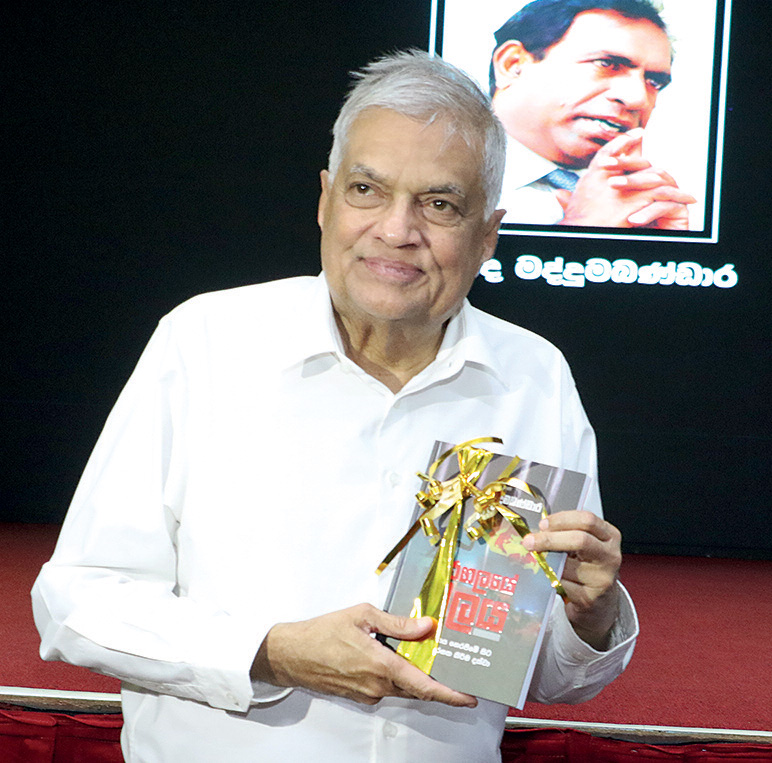
Ex-President Wickremesinghe with a copy of Aragalaye Balaya he received from its author, Prof. Professor Sunanda Maddumabandara, at the Sri Lanka Foundation recently (pic by Nishan S Priyantha)
On the basis of what Abeywardena had disclosed to him, Maddumabanadara also questioned the circumstances of the deployment of the elite Special Task Force (STF) contingent at the compound. The author asked whether that deployment, without the knowledge of the Speaker, took place with the intervention of Baglay.
Aragalaye Balaya
is a must read for those who are genuinely interested in knowing the unvarnished truth. Whatever the deficiencies and inadequacies on the part of the Gotabaya Rajapaksa administration, external powers had engineered a change of government. The writer discussed the issues that had been raised by Prof. Maddumabandara and, in response to one specific query, the author asserted that in spite of India offering support to Gotabaya Rajapaksa earlier to get Ranil Wickremesinghe elected as the President by Parliament to succeed him , the latter didn’t agree with the move. Then both the US and India agreed to bring in the Speaker as the Head of State, at least for an interim period.
If Speaker Abeywardena accepted the offer made by India, on behalf of those backing the dastardly US backed project, the country could have experienced far reaching changes and the last presidential election may not have been held in September, 2004.
After the conclusion of his extraordinary assignment in Colombo, Baglay received appointment as New Delhi’s HC in Canberra. Before Colombo, Baglay served in Indian missions in Ukraine, Russia, the United Kingdom, Nepal and Pakistan (as Deputy High Commissioner).
Baglay served in New Delhi, in the office of the Prime Minister of India, and in the Ministry of External Affairs as its spokesperson, and in various other positions related to India’s ties with her neighbours, Europe and multilateral organisations.
Wouldn’t it be interesting to examine who deceived Weerawansa and Thoradeniya who identified US Ambassador Chung as the secret visitor to the Speaker’s residence. Her high-profile role in support of the project throughout the period 31 March to end of July, 2022, obviously made her an attractive target but the fact remains it was Baglay who brought pressure on the then Speaker. Mahinda Yapa Abeywardena’s clarification has given a new twist to “Aragalaya’ and India’s diabolical role.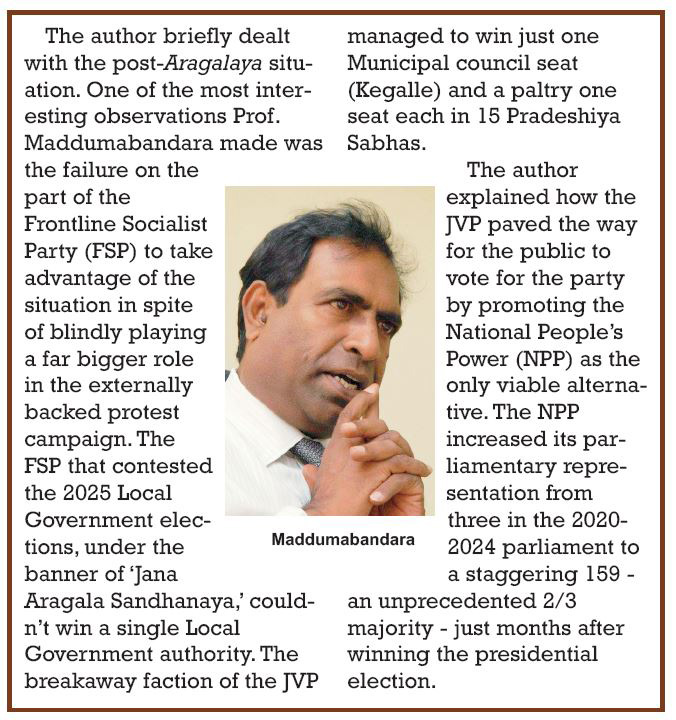
Absence of investigations
Sri Lanka never really wanted to probe the foreign backed political plot to seize power by extra-parliamentary means. Although some incidents had been investigated, the powers that be ensured that the overall project remained uninvestigated. In fact, Baglay’s name was never mentioned regarding the developments, directly or indirectly, linked to the devious political project. If not for Prof. Maddumabandara taking trouble to deal with the contentious issue of regime change, Baglay’s role may never have come to light. Ambassador Chung would have remained the target of all those who found fault with US interventions. Let me be clear, the revelation of Baglay’s clandestine meeting with the Speaker didn’t dilute the role played by the US in Gotabaya Rajapaksa’s removal.
If Prof. Maddumabandara propagated lies, both the author and Abeywardana should be appropriately dealt with. Aragalaye Balaya failed to receive the desired or anticipated public attention. Those who issue media statements at the drop of a hat conveniently refrained from commenting on the Indian role. Even Abeywardena remained silent though he could have at least set the record straight after Ambassador Chung was accused of secretly meeting the Speaker. Abeywardena could have leaked the information through media close to him. Gotabaya Rajapaksa and Ranil Wickremesinghe, too, could have done the same but all decided against revealing the truth.
A proper investigation should cover the period beginning with the declaration made by Gotabaya Rajapaksa’s government, in April 2022, regarding the unilateral decision to suspend debt repayment. But attention should be paid to the failure on the part of the government to decide against seeking assistance from the International Monetary Fund (IMF) to overcome the crisis. Those who pushed Gotabaya Rajapaksa to adopt, what they called, a domestic solution to the crisis created the environment for the ultimate collapse that paved the way for external interventions. Quite large and generous Indian assistance provided to Sri Lanka at that time should be examined against the backdrop of a larger frightening picture. In other words, India was literally running with the sheep while hunting with the hounds. Whatever the criticism directed at India over its role in regime change operation, prompt, massive and unprecedented post-Cyclone Ditwah assistance, provided by New Delhi, saved Sri Lanka. Rapid Indian response made a huge impact on Sri Lanka’s overall response after having failed to act on a specific 12 November weather alert.
It would be pertinent to mention that all governments, and the useless Parliament, never wanted the public to know the truth regarding regime change project. Prof. Maddumabandara discussed the role played by vital sections of the armed forces, lawyers and the media in the overall project that facilitated external operations to force Gotabaya Rajapaksa out of office. The author failed to question Wickremesinghe’s failure to launch a comprehensive investigation, with the backing of the SLPP, immediately after he received appointment as the President. There seems to be a tacit understanding between Wickremesinghe and the SLPP that elected him as the President not to initiate an investigation. Ideally, political parties represented in Parliament should have formed a Special Parliamentary Select Committee (PSC) to investigate the developments during 2019 to the end of 2022. Those who had moved court against the destruction of their property, during the May 2022 violence directed at the SLPP, quietly withdrew that case on the promise of a fresh comprehensive investigation. This assurance given by the Wickremesinghe government was meant to bring an end to the judicial process.
When the writer raised the need to investigate external interventions, the Human Rights Commission of Sri Lanka (HRCSL) sidestepped the issue. Shame on the so-called independent commission, which shows it is anything but independent.
Sumanthiran’s proposal
Since the eradication of the Liberation Tigers of Tamil Eelam (LTTE) in May 2009, the now defunct Tamil National Alliance’s (TNA) priority had been convincing successive governments to withdraw the armed forces/ substantially reduce their strength in the Northern and Eastern Provinces. The Illankai Thamil Arasu Kadchi (ITAK)-led TNA, as well as other Tamil political parties, Western powers, civil society, Tamil groups, based overseas, wanted the armed forces out of the N and E regions.
Abeywardena also revealed how the then ITAK lawmaker, M.A. Sumanthiran, during a tense meeting chaired by him, in Parliament, also on 13 July, 2022, proposed the withdrawal of the armed forces from the N and E for redeployment in Colombo. The author, without hesitation, alleged that the lawmaker was taking advantage of the situation to achieve their longstanding wish. The then Speaker also disclosed that Chief Opposition Whip Lakshman Kiriella and other party leaders leaving the meeting as soon as the armed forces reported the protesters smashing the first line of defence established to protect the Parliament. However, leaders of minority parties had remained unruffled as the situation continued to deteriorate and external powers stepped up efforts to get rid of both Gotabaya Rajapaksa and Ranil Wickremesinghe to pave the way for an administration loyal and subservient to them. Foreign powers seemed to have been convinced that Speaker Abeywardena was the best person to run the country, the way they wanted, or till the Aragalaya mob captured the House.
The Author referred to the role played by the media, including social media platforms, to promote Gotabaya Rajapaksa’s successor. Maddumamabandara referred to the Hindustan Times coverage to emphasise the despicable role played by a section of the media to manipulate the rapid developments that were taking place. The author also dealt with the role played by the Janatha Vimukthi Peramuna (JVP) in the project with the focus on how that party intensified its actions immediately after Gotabaya Rajapaksa stepped down.
Disputed assessment
The Author identified Ministers Bimal Rathnayaka, Sunil Handunetti and K.D. Lal Kantha as the persons who spearheaded the JVP bid to seize control of Parliament. Maddumabanda unflinchingly compared the operation, mounted against Gotabaya Rajapaksa, with the regime change operations carried out in Iraq, Libya, Egypt and Ukraine. Asserting that governments loyal to the US-led Western block had been installed in those countries, the author seemed to have wrongly assumed that external powers failed to succeed in Sri Lanka (pages 109 and 110). That assertion is utterly wrong. Perhaps, the author for some unexplained reasons accepted what took place here. Nothing can be further from the truth than the regime change operation failed (page 110) due to the actions of Gotabaya Rajapaksa, Mahinda Yapa Abeywardana and Ranil Wickremesinghe. In case, the author goes for a second print, he should seriously consider making appropriate corrections as the current dispensation pursues an agenda in consultation with the US and India.
The signing of seven Memorandums of Understanding (MoUs) with India, including one on defence, and growing political-defence-economic ties with the US, have underscored that the JVP-led National People’s Power (NPP) may not have been the first choice of the US-India combine but it is certainly acceptable to them now.
The bottom line is that a democratically elected President, and government, had been ousted through unconstitutional means and Sri Lanka meekly accepted that situation without protest. In retrospect, the political party system here has been subverted and changed to such an extent, irreparable damage has been caused to public confidence. External powers have proved that Sri Lanka can be influenced at every level, without exception, and the 2022 ‘Aragalaya’ is a case in point. The country is in such a pathetic state, political parties represented in Parliament and those waiting for an opportunity to enter the House somehow at any cost remain vulnerable to external designs and influence.
Cyclone Ditwah has worsened the situation. The country has been further weakened with no hope of early recovery. Although the death toll is much smaller compared to that of the 2004 tsunami, economic devastation is massive and possibly irreversible and irreparable.
By Shamindra Ferdinando
Features
Radiance among the Debris
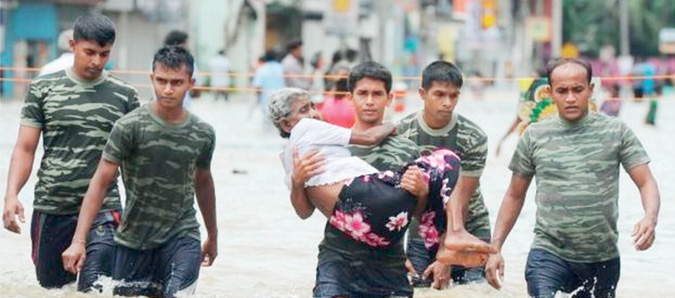
Over the desolate watery wastes,
Dulling the glow of the fabled Gem,
There opens a rainbow of opportunity,
For the peoples North and South,
To not only meet and greet,
But build a rock-solid bridge,
Of mutual help and solidarity,
As one undivided suffering flesh,
And we are moved to say urgently-
‘All you who wax so lyrically,
Of a united nation and reconciliation,
Grab this bridge-building opportunity.’
By Lynn Ockersz
-

 Features7 days ago
Features7 days agoFinally, Mahinda Yapa sets the record straight
-
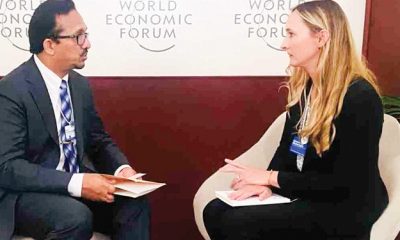
 Features7 days ago
Features7 days agoHandunnetti and Colonial Shackles of English in Sri Lanka
-
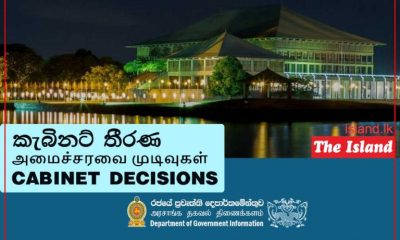
 Business5 days ago
Business5 days agoCabinet approves establishment of two 50 MW wind power stations in Mullikulum, Mannar region
-

 News6 days ago
News6 days agoGota ordered to give court evidence of life threats
-

 Features6 days ago
Features6 days agoCliff and Hank recreate golden era of ‘The Young Ones’
-
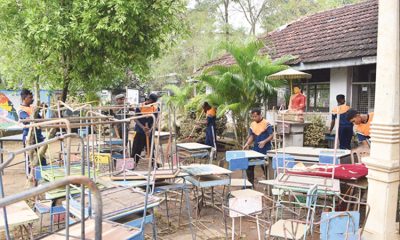
 Opinion7 days ago
Opinion7 days agoA national post-cyclone reflection period?
-
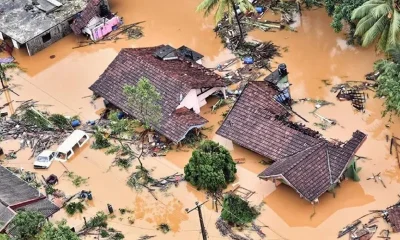
 Features6 days ago
Features6 days agoSri Lanka and Global Climate Emergency: Lessons of Cyclone Ditwah
-

 Latest News6 days ago
Latest News6 days agoSri Lanka squad named for ACC Men’s U19 Asia Cup













